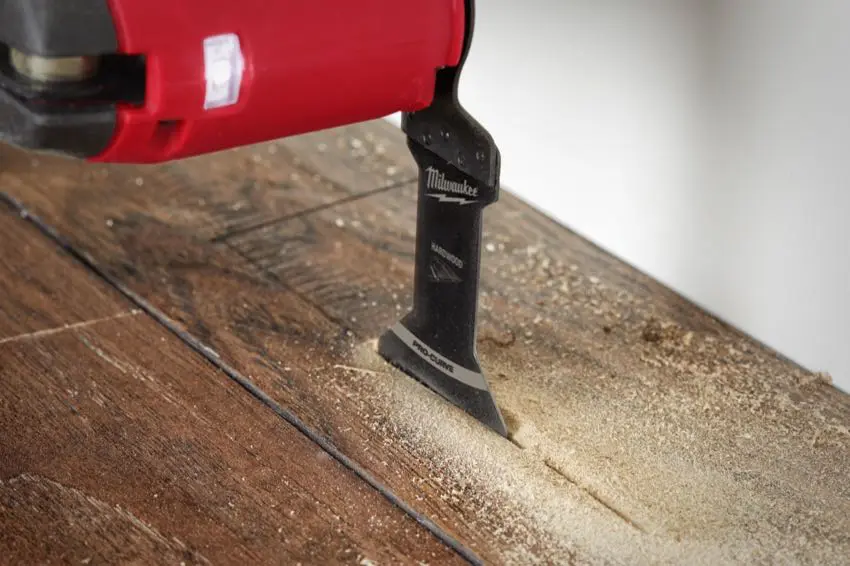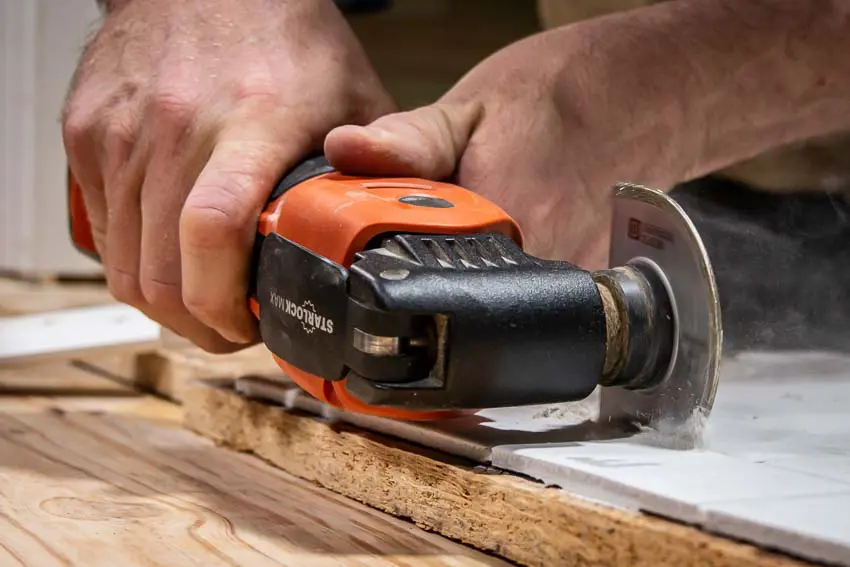What is an oscillating multi-tool used for? It’s pretty obvious by looking at the box that they can cut and sand, but so can other tools. So, are they really necessary?
Absolutely. In this article, I’ll show you six key functions of an oscillating tool and help you decide if it’s a power tool you should own.
Back to basics: What is an oscillating multi-tool?
How an Oscillating Multi-Tool Works
Before we jump into what an oscillating multi-tool is used for, it’s helpful to have a basic understanding of how it works. Conceptually, it’s simple—the motor oscillates back and forth, which is how the tool got its name. That oscillating motion transfers to any accessory you attach.
The angle of oscillation is part of what determines how fast the tool works. Most models range from 3.2° to 4.0° of motion on each oscillation. The wider the angle, the more interaction the accessory has with your workpiece.
The other part is how quickly the tool oscillates. Pro models can reach 20,000 oscillations per minute (OPM), and most quality models have adjustable speeds to match the speed to the task. When you combine high speed with a large oscillating angle, you get the fastest working speeds.
Get your hands on one of our best oscillating multi-tools of the year!
Use an Oscillating Multi-Tool For Plunge Cutting

Oscillating tools are designed for otherwise impossible plunge cuts. With the right blade, they’re super-easy to accomplish. While it’s common to use multi-tools to plunge cut holes in drywall for electrical boxes, they can tackle any job that needs a plunge cut. Some of these include starting a mortise, making a notch, and cutting trim or casings for flooring.
To make a plunge cut, turn the tool on and plunge the blade straight into your material. Since the oscillating action keeps the blade’s teeth working, all you have to do is hold the tool steady and gently push it through the cut.
Pro Tip: You can install blades at different angles to better reach where you’re cutting or create a more comfortable cutting angle.
Use an Oscillating Multi-Tool For Straight Cuts

Using an oscillating multi-tool, you can make straight cuts in a variety of materials, including drywall, wood, and metal. In fact, you’ll typically find each straight-cutting application has its own dedicated blade type.
For longer straight cuts, use a segmented half-moon blade. For plunging and making small cutout cuts, a straight plunge blade works great. Bi-metal and carbide blades can help you cut through metal. Though more expensive, carbide blades have the longest life in metal cutting.
To make a straight cut, plunge the blade in at the entry point, angle the tool to face the direction you want to cut in and push it forward until you reach the end. Feel free to change the attachment angle of the blade if it puts the tool in a more comfortable position for you.
Use an Oscillating Multi-Tool For Detail Sanding

If you swap the blade attachment for the sanding attachment, you can use your oscillating multi-tool as a detail sander. It’s not a replacement for the speed and coverage of handheld sanders, but it works well for small areas. We like the control it gives us over our work, and it’s able to reach into areas standard sanders are too big for.
To sand, turn the tool on, press the sanding pad against your material, and move the sander around in a circular motion to get an even finish.
Pro Tip: Use a low-grit pad (like 60-grit) for fast material removal and a high-grit pad (like 240-grit) for the smoothest finish.
Use an Oscillating Multi-Tool to Strip, Peel, and Scrape

You can easily remove old paint, that “beautiful” old linoleum floor, unidentifiable gunk, and more with a scraping blade for an oscillating multi-tool. I’m sure you can think of at least three places to use this function right now.
While you shouldn’t use an oscillating multi-tool to scrape an entire floor (that would take forever), you can use them in small areas to scrape stubborn material off that larger tools miss.
For this use, you need to drop the angle of the tool so that it’s close to parallel with the surface you’re working on. You want the edge of the blade to slide under what you’re removing without digging into the material it’s attached to. Once you get it started, keep pushing the tool forward to make progress.
Use an Oscillating Multi-Tool to Remove Grout and Caulk

Removing old grout and caulk for a bathroom remodel is one of the most effective uses for an oscillating multi-tool. Caulk comes right up, and grout clears out quickly. With just a little bit of practice, you can clear out the old stuff without damaging the material behind it.
For this job, you need a half-moon diamond blade. It’s like having low-grit sandpaper that only covers the edge of a blade but doesn’t get dull like sandpaper.
Start by gently pushing the edge down into the material you’re removing until you get through it completely. Then push the tool forward and follow the caulk or grout line to the end.
Pro Tip: Removing grout can be messy. Consider wearing a respirator mask to avoid breathing in the dust you create.
Use an Oscillating Multi-Tool to Undercut Trim for Tile and Flooring

One of the most common ways Pros use an oscillating multi-tool is for undercutting trim to make room for tile or other flooring. By having the flooring material slide under the trim, you end up with a high-quality Pro finish, and frankly, it’s easier than trying to custom-cut the flooring to fit around the trim.
Any wood-cutting blade works, but a good Japanese tooth blade will make quick work of hardwood trim. If you suspect you might hit nails, opt for a blade with carbide teeth. Not only will it get the job done, but it should hold up for dozens of jobs.
To make the cut, push a loose tile against the trim you’re cutting. This acts as a gauge to cut at exactly the right height. With the blade flush against the top of the tile, push it into the trim until you feel it cut through the back. Pull the blade straight out and repeat the process as you work around the trim piece.
Pro Tip: Make your undercuts before you install flooring close to the trim. This gives you plenty of room to work around the trim pieces without other flooring material getting in your way.
Final Thoughts
While these are some of the most common jobs you can use an oscillating multi-tool for, it’s far from being an exhaustive list. The main limitations are what accessories you can find and your imagination. Pros in almost every trade can find a use for them, and many DIY enthusiasts will be glad they have one for a variety of projects and repairs. As one of the more affordable power tools available and with nearly every cordless tool brand having at least one option, go out and grab one. Sooner or later, you’ll be glad you did.



